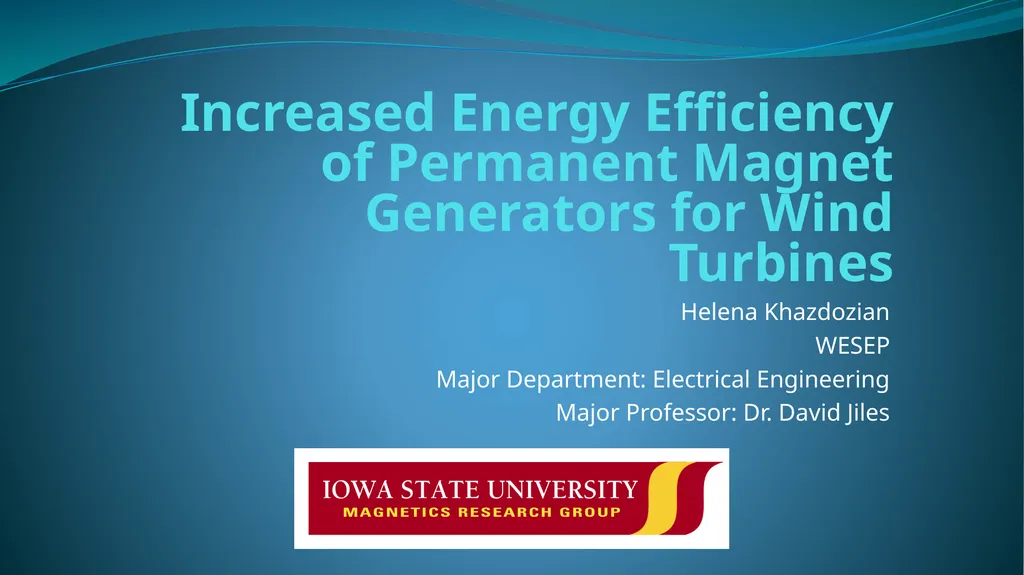Increased Energy Efficiency of Permanent Magnet
Author : giovanna-bartolotta | Published Date : 2025-05-12
Description: Increased Energy Efficiency of Permanent Magnet Generators for Wind Turbines Helena Khazdozian WESEP Major Department Electrical Engineering Major Professor Dr David Jiles Outline Problem Definition Commercial Wind Turbines Permanent
Presentation Embed Code
Download Presentation
Download
Presentation The PPT/PDF document
"Increased Energy Efficiency of Permanent Magnet" is the property of its rightful owner.
Permission is granted to download and print the materials on this website for personal, non-commercial use only,
and to display it on your personal computer provided you do not modify the materials and that you retain all
copyright notices contained in the materials. By downloading content from our website, you accept the terms of
this agreement.
Transcript:Increased Energy Efficiency of Permanent Magnet:
Increased Energy Efficiency of Permanent Magnet Generators for Wind Turbines Helena Khazdozian WESEP Major Department: Electrical Engineering Major Professor: Dr. David Jiles Outline Problem Definition Commercial Wind Turbines Permanent Magnet Generators Magnetic Materials Soft Magnet Materials Hard Magnet Materials Alternative Materials Approach to Research Problem Definition Broad Definition: Energy Crisis! U.S. relies on fossil fuels to generator power Contributes to climate change Solution: Wind Energy Source: O. Gutfleisc et al, Adv. Mater. 23, 2001, 821-842 Source: I. Kubiszewski, C. Cleveland, “Energy return on investment (EROI) for wind energy,” The Encyclopedia OF EARTH, 3/28/2013 Commercial Wind Turbines 3 phase induction generators are industry standard Require multistage gearboxes Gearboxes fail before designed lifetime of 20 years and account for majority of system losses High operation and maintenance costs Variable speed operation is expensive Direct drive permanent magnet generators present an efficient alternative Need for Renewable Energy Need for Alternative Generators in Wind Turbines Problem Definition Permanent Magnet Generators (PMG) Synchronous operation Direct drive Drive shaft coupled to turbine blade rotors Rotor Generates field/excitation current Rotor disk Permanent magnet blocks Provides magnetic flux Stator 3 phase voltage induced in copper windings Commercial efficiencies 85-98% Permanent Magnet Generators (PMG) Advantages Elimination of gearbox Variable speed operation Higher energy yield Disadvantages High torque, low speed operation Cogging torque More expensive Requires inverter for grid connection Increase in size and mass of generator with increase in output power Design challenge! Need for Renewable Energy Need for Alternative Generators in Wind Turbines Problem Definition Need for Efficient PMG with Reduced Size and Mass Efficiency Losses Cu losses I2R losses Fe losses Core losses, eddy current losses Rotational/mechanical losses Can we reduce these with material choices? Permanent Magnet Generators (PMG) Magnetic Materials Soft magnetic materials High saturation magnetization, Ms High permeability Low coercivity, Hc Low core loss Hard magnetic materials High remanence, Br High coercivity, Hc Energy Product = (BH)max Soft Magnetic Materials Application Rotor disk Stator (steel laminations) Types of Soft Materials Electrical steels FeNi and FeCo alloys Ferrites Amorphous metals Reduce core loss through material choice Permanent Magnetic (PM) Materials PMs are hard magnetic materials Provides flux in PMG Types of PM Materials Rare Earths Nd-Fe-B Sm-Co Non-Rare Earths Alnico Ceramics/hard ferrites Need for Renewable Energy Need for Alternative Generators in Wind Turbines Problem Definition Need for Efficient PMG with Reduced Size and Mass Need to Reduce Critical Materials in PMG Permanent Magnetic (PM) Materials Nd-Fe-B














